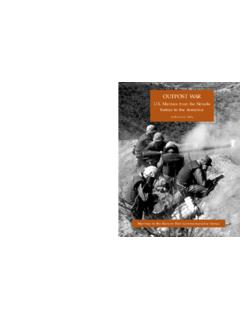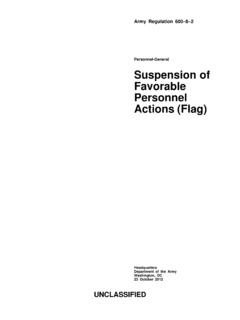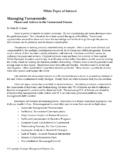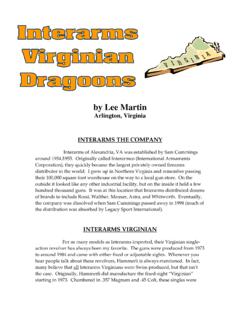Transcription of Combat Actions in Korea - Korean War
1 IvARMY HISTORICAL SERIESCOMBAT Actions IN KOREAR ussell A. GugelerCENTER OF MILITARY HISTORYUNITED STATES ARMYWASHINGTON, , 1987 Library of Congress Catalog Card Number: 70-603408 First Printed 1954 CMH Pub 30-2 For sale by the Superintendent of Documents, Government Printing OfficeWashington, 20402 Foreword* This book was originally published in 1954, revised in 1970, and indemand and print since then. The accounts of small-unit Actions were writtenprimarily for junior officers, noncommissioned officers, and privates of the UnitedStates Army who had not yet been in battle. The object was to acquaint themwith the realities of their own the Korean War, some of the tools and procedures of battle havechanged, but the basic conditions of Combat have not. Indeed, the surprises, con-fusion, and problems faced on one battlefield generally resemble the difficultiesmet on another.
2 Accounts of battle experience at other times in other places, then,continue to have instructive value. It is with this fact in mind that this book isbeing of the accounts contained in the original version was omitted after areview of the source material on which it was based revealed several irreconcilableerrors. All of the other episodes appearing in the 1970 revised edition continue toappear in their original form. Those who absorb the lessons they offer can substan-tially increase their competence as leaders and members of small units in battle,and all students of military history should find profit in these intimate and objectivestories of Combat Center of Military History is pleased to continue this popular , DOUGLAS KINNARD20 July 1984 Brigadier General, USA (Ret.)
3 Chief of Military History* This book is a collection of accounts describing the Combat action ofsmall Army units squads and platoons, companies and batteries. These are theunits that engage in Combat , suffer the casualties, and make up the fighting strengthof the battalions, regiments, divisions, corps, and finally, of the field army. Combatis a very personal business to members of such a small unit. Concerned with thefearful and consuming tasks of fighting and living, these men cannot think ofwar in terms of the Big Picture as it is represented on the situation maps at corpsor army headquarters. Members of a squad or platoon know only what they cansee and hear of Combat . They know and understand the earth for which they fight,the advantage of holding the high ground, the protection of the trench or men can distinguish the sounds of enemy weapons from those of their own;they know the satisfying sound of friendly artillery shells passing overhead andof friendly planes diving at an objective.
4 They know the excitement of Combat , thefeeling of exhilaration and of despair, the feeling of massed power, and ofoverwhelming author has tried to describe Combat as individuals have experienced it,or at least as it has appeared from the company command post. In so doing, muchdetail has been included that does not find its way into more barren official details and the little incidents of Combat were furnished by surviving membersof the squads and companies during painstaking interviews and discussions soonafter the fighting was over. Conversely, many facts have been omitted from thenarrative presented here. The accounts tell only part of the complete story, inten-tionally ignoring related Actions of cause and effect in order to keep one or twosmall units in sharper focus. The story of action on Heartbreak Ridge, for example,describes fighting that lasted only one or two hours, whereas the entire battle forthat hill went on for several weeks.
5 Sometimes there are obvious gaps becauseVPrefacePrefaceimportant information was lost with the men who died in the battle. Sometimesthe accounts are incomplete because the author failed to learn or to recounteverything of importance that stories that follow have been selected as representative of the importantbattles of the Korean conflict. In chronological sequence, they follow the fightingbeginning on the second day of the participation of United States troops until thewar settled into a static defense of fortified most of the peninsula is covered with an intricate mass of hills andridges, many of the battles in Korea took place on hilltops. The typical Koreanridge rises from rice paddies and a stream at its base and slants upward at anangle of forty-five or more degrees. It takes an hour of steady climbing to reachthe top and, once they have reached the path-wide crest, the sweating infantrymensee only another ridge ahead, and others beyond it, stretching in row after rowto the purple haze at the horizon, In the wintertime the hills are windblown andharsh but when summer rains come to Korea and the morning mist drifts alongthe ridgelines there is a fresh beauty to the land.
6 The hills become verdant andbetween them the rice paddies, in delicate shades of green, are so neat they lookas if someone had combed them by hand and set them out in the sun. Other thanthe beauty of the landscape, American soldiers find little that is desirable in has always been a poor land, and the shifting Combat has reduced many of thevillages to heaps of red ashes, many of the people to destitution. In the combatzone only the hills seem unchanged, and even a few of them are beaten up andbare from the fighting. This is the setting for the stories that preparation of this book has not been a one-man project. Major GeneralOrlando Ward, Army (now retired), is responsible for the book, havingplanned it and furnished much of the enthusiasm and inspiration necessary to getthe writing done.
7 It is a personal pleasure for the author to share the credit forthe book with nine officers with whom he worked and often shared tents in officers, members of historical detachments, were engaged in collecting andpreserving accurate historical records of the Korean conflict. From the large numberof accounts that they prepared, the author has included eleven that were eitherpartially or almost wholly prepared by them. To the following officers the authoris indebted for this valuable assistance and for the pleasure of sharing the experi-ences of Korea : Major Edward C. Williamson, Captain John Mewha, CaptainMartin Blumenson, Major B. C. Mossman, Major Pierce Briscoe, Major William , Lieutenant Bevin R. Alexander, Lieutenant Edgar Denton, and MajorRobert H. author reserves a special acknowledgment of indebtedness and anexpression of appreciation to Lt.
8 Co!, Roy E. Appleman. During both WorldWar II and the Korean War, the author benefited from Colonel Appleman sfamiliarity with military history and from his sturdy good for one, the discussions following most of the action accounts werecompiled by Lt. Colonel Carl D. McFerren of the Office of the Chief of MilitaryHistory, and based upon comments from the Army schools at Fort Benning,Fort Sill, and Fort Knox. At the request of the Chief of Military History, Lieu-tenant Nicholas A. Canzona, Marine Corps, wrote the discussion following Attack Along a Ridgeline. Thediscussions do not necessarily reflect the officialview of the Department of the Army, but are included to stimulate thought andpromote discussion. No attempt has been made to mention everything that iseither good or bad about the conduct of the battles described and, in many cases,the obvious has been intentionally avoided.
9 Neither has there been any attemptto place blame, since no one can claim that, in the same circumstances, he couldhave done Mary Ann Bacon has been generous in giving skillful editorial guidanceto the author. Mr. Alfred M. Beck accomplished the numerous tasks required toconvert the original publication into the present edition. Mrs. Vivian Brooks pre-pared all maps illustrating the text, and Mr. Robert Johnstone prepared the twopen-and-ink sketches. To them the author is deeply , the author is anxious to thank several hundred men and officers ofthe United States Army who have been both patient and generous in furnishingthe information upon which the accounts are based. Without their cooperationthis book could not have been written and eventually much of the informationpresented here would have been lost, just as the dust and smoke disappear fromthe battlefield when the fighting is A.
10 GUGELERS tuttgart, Germany30 September 1969 ContentsFOREWORD .. PREFACE .. 1 WITHDRAWAL action .. 2 ATTACK ALONG A RIDGELINE .. 3 DEFENSE OF A BATTERY POSITION .. 4 TANK action AT CHONGJU .. 5 ARTILLERY AT KUNU-RI .. 6 CHOSIN RESERVOIR .. 7 TWIN TUNNELS PATROL AMBUSH .. 8 CHIPYONG-NI .. 9 TASK FORCE CROMBEZ .. 10 TANK SUPPORT .. 11 A RIFLE COMPANY AS A COVERING FORCE .. 12 ARTILLERY IN PERIMETER DEFENSE.. 13 HILL 800 (BUNKER HILL) .. 14 TASK FORCE GERHARDT .. 15 MILLION DOLLAR HILL .. 16 BLOODY RIDGE .. 17 HEARTBREAK RIDGE .. 18 OUTPOST EERIE .. 19 Combat PATROL .. LEGEND TO SYMBOLS ON MAPS .. INDEX .. Page..iiiv320313945548010012613714415416 6183193202215222236246247 Combat Actions in KoreaWe was rotten fore we started we was never disciplined;We made it out a favour if an order was , every little drummer ad is rights an wrongs to mind,So we had to pay for teachin an we paid!










